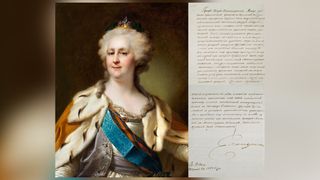Empress Catherine the Great's letter on smallpox vaccination to go up for auction
"Such inoculation should be common everywhere."

A letter written by Russian empress Catherine the Great on April 20, 1787, stressing the importance of the smallpox vaccine to the count of Malorossiya (modern-day Ukraine), will go up for auction on Dec. 1 at MacDougall's in London, according to news reports.
That letter, previously held in an anonymous private collection, was recently displayed for the first time in Moscow and will go up for auction at MacDougall's auction house in London On Dec. 1, according to the Moscow Times.
Catherine the Great, who ruled Russia from 1762 to 1796, was a major advocate for vaccination at a time when there was a lot of public resistance to the idea, according to MacDougall's. In 1768, she became the first person in Russia to be vaccinated against smallpox, and she had her son vaccinated soon after.
Related: 5 scariest disease outbreaks of the past century
The smallpox virus devastated the world for at least 3,000 years, before modern vaccination campaigns wiped it out in 1980, according to the World Health Organization (WHO). In 18th-century Europe, smallpox would sometimes kill off entire villages at once, according to MacDougall's.
The first successful smallpox vaccine wasn't available until 1796, when an English Doctor Edward Jenner realized that milkmaids who had caught cowpox did not catch smallpox, according to the WHO. Prior to that, during the time of Catherine the Great's reign, vaccination involved exposing people to the smallpox virus itself.
Doctors would cut incisions in a healthy person's arm and insert threads of fabrics containing pus from a person infected with smallpox, according to MacDougall's. This primitive vaccination method made people sick for some time and had a 2% risk of death, or about 20 times lower than if a person was naturally infected with smallpox.
Sign up for the Live Science daily newsletter now
Get the world’s most fascinating discoveries delivered straight to your inbox.
"Among the other duties of the Welfare Boards in the Provinces entrusted to you, one of the most important should be the introduction of inoculation against smallpox, which, as we know, causes great harm, especially among the ordinary people," Catherine the Great wrote in Cyrllic, a Slavic alphabet, in the newly unveiled letter addressed to Count Piotr Aleksandrovich, the governor-general and vice-regent of Malorossiya. "Such inoculation should be common everywhere."
In the letter, she wrote that the count should order each town to build temporary lodgings in abolished convents or small monasteries for people who couldn't be vaccinated at home.
The letter is "unique, especially given this situation we are all in," Oleg Khromov, a historian, told reporters via video at a press conference on Thursday (Nov. 18), according to The Moscow Times.
Nowadays, vaccines are much safer than they were 200 years ago, but amid the unprecedented COVID-19 pandemic, many countries such as the U.S. and Russia are still battling widespread vaccine hesitancy.
When Louis XV, the ruler of France, died of smallpox in 1774, Catherine the Great reportedly said it was "barbarism" to die of the disease when they were living in the enlightened 18th century, according to the Moscow Times.
"I very much hope that one day, maybe in the near future, we can say: 'What barbarism to die of COVID in the 21st century'," Yekaterina MacDougall, the auction house's co-director and Russian art expert, said at the press conference.
The letter will be auctioned along with a portrait of Catherine the Great, which together are estimated to be worth up to $1.6 million, according to The Moscow Times.
Originally published on Live Science.

Yasemin is a staff writer at Live Science, covering health, neuroscience and biology. Her work has appeared in Scientific American, Science and the San Jose Mercury News. She has a bachelor's degree in biomedical engineering from the University of Connecticut and a graduate certificate in science communication from the University of California, Santa Cruz.
